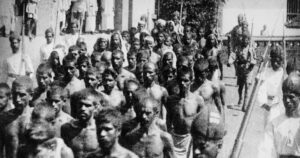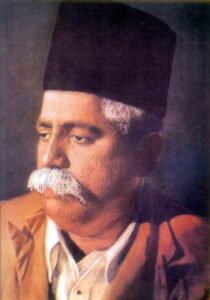[ Reported as seen ]
On the morning of September 4th, during the celebration of Lakshmi Puja, Hindus conducted their annual procession in Nagpur, passing by a mosque in the Mahal area. However, Muslims obstructed the procession and prevented it from proceeding through the area. In the afternoon, while Hindus were resting after the morning procession, Muslim youths organized a procession, armed with weapons such as javelins, daggers, and knives, shouting “Allahu Akbar.” Tensions escalated as Muslim youths threw stones at the house of Hedgewar, the leader of the RSS, and RSS cadres retaliated with lathis. The riots lasted for two days, resulting in 22 deaths and over 100 injuries. The government eventually deployed troops to restore peace, and during the riots, the RSS positioned its cadres in various locations across the city to protect Hindu communities. These events are described in Liaquat Ali Khan’s book “Pakistan – The Heart of Asia” as well, highlighting a significant premeditated arson incident that involved explosives gathered prior to the riots.
Introduction
The Nagpur riots of 1927 marked a significant chapter in the series of communal conflicts that unfolded across various cities in British India during the 1920s. Nagpur, the capital of Central Provinces and Berar (CP&B) state, played host to these riots on 4th September 1927.[1] The events were set in motion during a procession for Mahalakshmi, which faced obstruction from Muslims upon reaching the Mahal neighborhood. As tensions escalated, violent clashes erupted near Hindu residences in the vicinity, resulting in a three-day-long period of rioting and unrest.

During this tumultuous period, the city of Nagpur, situated in central India, bore witness to communal strife that not only disrupted the social fabric but also left a lasting impact on the collective memory of the region. The confrontations between different religious communities underscored the deep-seated divisions prevailing within society and exposed the fragility of interfaith relations during that time.
The rioting, characterized by clashes between Hindus and Muslims, led to widespread fear, destruction, and loss of life. The tensions and animosities that had been simmering beneath the surface for some time erupted into open conflict, pitting neighbors and community members against one another. The riots left an indelible mark on the affected neighborhoods and reverberated throughout British India, sparking debates and discussions on communal harmony, religious tolerance, and the need for effective governance to prevent such incidents.
The Nagpur riots of 1927 were a stark reminder of the challenges faced by a diverse and pluralistic society striving for harmony amidst religious and cultural differences. The events served as a wake-up call, prompting introspection and a renewed commitment to fostering communal amity and understanding. The consequences of these riots would shape the socio-political landscape of the region and contribute to the broader discourse on interfaith relations in British India.
Background
The 1920s in India witnessed a deteriorating sense of mutual trust and communal harmony between the Hindu and Muslim communities, resulting in frequent outbreaks of riots across various cities. The escalation of violence was evident through the staggering number of recorded riots during this period. In 1923 alone, eleven riots took place, followed by eighteen in 1924, sixteen in 1925, and thirty-five in 1926. The trend continued in the subsequent months, with an additional forty riots erupting across different cities from May 1926 to April 1927. Regions like Bengal, Punjab, North-West Frontier Province, and United Provinces were particularly affected by these conflicts.
Among the series of riots, the Lahore riots of August 1927 stood out as one of the deadliest recorded incidents. However, an earlier riot in 1923 served as a significant precursor to the growing tensions between the Hindu and Muslim communities. This particular riot occurred when members of the Hindu Mahasabha organized a procession that passed in front of a mosque, playing loud music. The Muslim community objected, triggering a skirmish between the two groups. These riots had a profound impact on K. B. Hedgewar, who was moved to form the Rashtriya Swayamsevak Sangh (RSS) in 1925. The RSS, a Hindu nationalist organization and one of the largest Hindu organizations in the world, emerged as a response to the deteriorating communal relations.
In his book “The Hindu Nationalist Movement and Indian Politics,” Christophe Jaffrelot recounts a testimony stating that Hedgewar, in an act of defiance, led a Ganesha procession in 1927, beating the drums as they passed in front of the mosque, contrary to the usual practice of avoiding such provocative gestures. These incidents, including the procession clash and subsequent riots, served as catalysts that intensified the underlying tensions between the two communities.
The cumulative impact of these riots, marked by communal violence and deepening divisions, prompted reflection on the fragile state of interfaith relations in India. The frequency and intensity of the conflicts underscored the urgent need for fostering understanding, respect, and tolerance among diverse religious groups. The events of the 1920s left an indelible mark on the socio-political landscape, shaping the trajectory of Hindu-Muslim relations and influencing the subsequent course of Indian history.
The massacre
On the morning of September 4th, coinciding with the auspicious occasion of Lakshmi Puja, Hindus in Nagpur initiated their annual procession as part of the festivities. However, this year, the procession faced a hurdle when it reached the Mahal area, as Muslims obstructed its passage near a mosque. Tempers flared, and in the afternoon, Muslim youths organized their own procession, armed with weapons such as javelins, daggers, and knives, and chanted “Allahu Akbar” (God is great).

Amid the escalating tension, the situation took a turn for the worse. Muslim youths targeted the house of Hedgewar, the leader of the Rashtriya Swayamsevak Sangh (RSS), pelting it with stones. It is worth noting that Hedgewar was not present in Nagpur at the time. In response, RSS cadres, sensing the growing unrest, took to the narrow lanes of the Mahal area, wielding lathis (sticks), further fueling the violence and exacerbating the riots. As the turmoil unfolded, a significant incident of arson occurred, seemingly premeditated with the accumulation of explosives well before the riots erupted, as described in Liaquat Ali Khan’s book, “Pakistan – The Heart of Asia.”
The Washington Post reported that the riots continued for two days, resulting in the deaths of 22 individuals and more than 100 people sustaining injuries. The severity of the situation prompted the government to intervene and deploy troops to restore order and peace in the city. Notably, during the riots, the RSS strategically organized its cadres into 16 shakhas (branches) scattered throughout the city, aiming to protect the Hindu communities from harm and provide support in the midst of the turmoil.
The Nagpur riots of 1927 exemplified a deepening divide between the Hindu and Muslim communities during that era. What began as a clash between two processions quickly spiraled into a violent confrontation, fueled by religious fervor and a lack of mutual understanding. The riots exposed the fragile nature of communal relations in Nagpur and reflected the broader tensions simmering across British India in the 1920s. The aftermath of the riots would have a lasting impact on the socio-political landscape, contributing to the shaping of subsequent events and underscoring the urgent need for interfaith dialogue, tolerance, and efforts to foster communal harmony.
Aftermath
The Nagpur riots of 1927 left a trail of destruction and loss for the Hindu community. Numerous Hindu homes and temples were subjected to vandalism, and a significant number of Hindus lost their lives, including 13 members of the Rashtriya Swayamsevak Sangh (RSS) who were brutally lynched by an enraged Muslim mob. The riots provided a platform for the RSS to showcase its role in defending Hindus during times of crisis, solidifying its position as a prominent organization in the eyes of the public.
News of the incident spread rapidly across the country, and the RSS experienced a surge in its popularity. This newfound recognition translated into a substantial increase in membership, as individuals sought to align themselves with an organization that demonstrated a commitment to protecting the interests of Hindus in the face of adversity. By 1929, the RSS had established a well-defined hierarchical structure, enabling it to effectively mobilize its efforts. The number of branches soared from 60 to 500 between 1931 and 1939, reflecting the organization’s rapid expansion and reach. With its growing influence, the RSS boasted a membership count of 60,000 during this period, further solidifying its position as a significant force within the Hindu community.
The Nagpur riots marked a turning point in the trajectory of the RSS. The organization emerged from the turmoil with heightened visibility and a larger support base. The events served as a catalyst for its growth and consolidation, as it positioned itself as a defender of Hindu interests and a bulwark against communal violence. The impact of the riots reverberated beyond Nagpur, resonating with individuals across the country who were drawn to the RSS’s message of protection and empowerment. The organization’s expanded presence and increased membership provided a platform for further engagement and advocacy on behalf of the Hindu community.
In subsequent years, the RSS continued to strengthen its roots, advancing its mission to promote Hindu unity, cultural revival, and social service. The Nagpur riots of 1927 played a pivotal role in shaping the organization’s evolution, propelling it into a period of accelerated growth and establishing its status as one of the most prominent Hindu organizations in India. The resonance of the riots, the plight of the affected Hindus, and the rise of the RSS underscored the importance of fostering harmony, understanding, and dialogue among different religious communities, emphasizing the need for peaceful coexistence in a diverse nation.
Conclusion
The Nagpur riots of 1927 were a tragic episode in India’s history, marked by violence and communal tensions. The aftermath of the riots witnessed the rise of the Rashtriya Swayamsevak Sangh (RSS) as a prominent organization dedicated to safeguarding the interests of Hindus. The widespread destruction of Hindu homes and temples, along with the loss of numerous lives, including RSS members, galvanized public sentiment and garnered support for the RSS’s mission.
The impact of the Nagpur riots extended far beyond the immediate aftermath. The incident served as a rallying point for Hindus across the country, leading to a surge in RSS membership and heightened visibility. The organization capitalized on this momentum to establish a structured hierarchy and expand its network of branches. By fostering a sense of unity and advocating for the rights and protection of Hindus, the RSS positioned itself as a formidable force in Indian society.
The growth and influence of the RSS in the years following the Nagpur riots reshaped the socio-political landscape of India. It played a significant role in promoting Hindu nationalism, cultural revival, and social service, shaping the discourse on religious identity and community relations. While the events of the Nagpur riots were marked by tragedy and communal strife, they also highlighted the importance of promoting harmony, understanding, and peaceful coexistence among different religious communities.
The Nagpur riots and their aftermath stand as a reminder of the need for dialogue, tolerance, and respect in a diverse nation like India. The scars of communal violence and the efforts of organizations like the RSS underscore the ongoing challenges of fostering communal harmony and building a pluralistic society. By reflecting on the lessons from the past, society can strive to create an inclusive and harmonious future, where the differences that divide us are transcended by the values that unite us as fellow citizens.
CITATIONS AND SOURCES
https://en.wikipedia.org/wiki/1927_Nagpur_riots
Nagpur Riots of 1923: How it played in Dr K.B Hedgewar’s life and lead to the formation of RSS
https://dbpedia.org/page/1927_Nagpur_riots
1927 Nagpur Riots: Birth of Riot template & the Bloody legacy of engineered riots in India.


![The 1927 Nagpur riots [ Maharashtra, India ]](https://projecthindukush.com/wp-content/uploads/1921-1-400x400.jpg)
![The 1927 Nagpur riots [ Maharashtra, India ]](https://projecthindukush.com/wp-content/uploads/download-30-400x400.jpg)
![The 1927 Nagpur riots [ Maharashtra, India ]](https://projecthindukush.com/wp-content/uploads/Dr._Hedgevar-400x400.jpg)
![The 1927 Nagpur riots [ Maharashtra, India ]](https://projecthindukush.com/wp-content/uploads/Fb0qsvXUYAAF0io-400x400.png)
